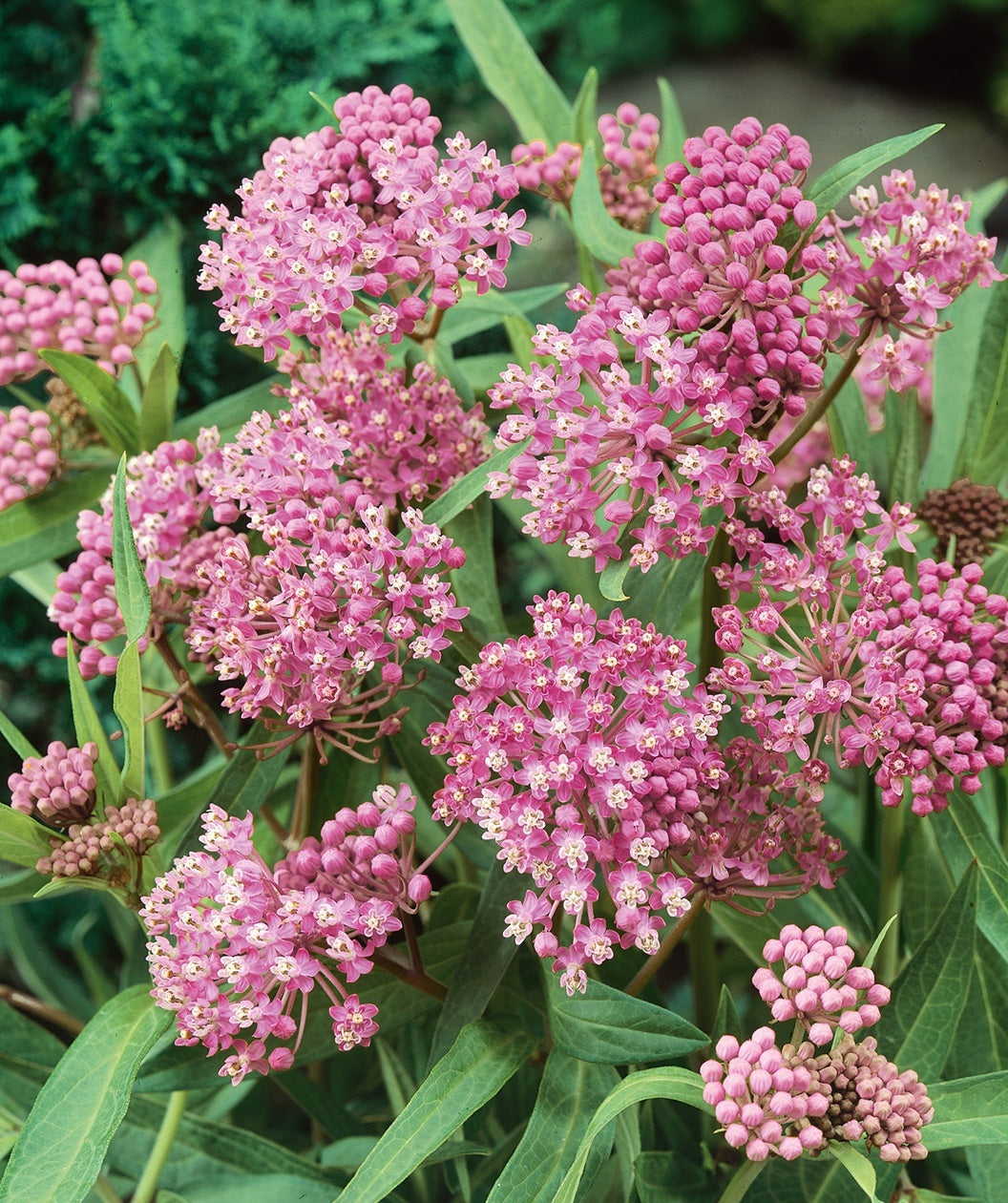


BLOSSOMS THAT ATTRACT AND PROVIDE FOR THE STRUGGLING MONARCH POPULATION
FEATURES:
- Rosey, pink blossoms, early in summer with a change to seedpods in late summer filled with fluffy parachutes that sail away in the breeze
- Lime green foliage shoots out beyond the blooms
- Attractive and extremely beneficial to the hummingbirds, butterflies, and every sort of pollinating creature
- Plant this as an addition to your pollinator garden or as an accent in a small open area in your landscape
- Hand Selected, Fresh from the Grower
- Ships in a plant-safe designed box
Growth Facts
- Hardiness Zone: 3-9
- Mature Height: 2-4' tall
- Mature Width: 1-3' wide
- Exposure: Full Sun
- Spacing: 1-3' apart
BLOSSOMS THAT ATTRACT AND PROVIDE FOR THE STRUGGLING MONARCH POPULATION
FEATURES:
- Rosey, pink blossoms, early in summer with a change to seedpods in late summer filled with fluffy parachutes that sail away in the breeze
- Lime green foliage shoots out beyond the blooms
- Attractive and extremely beneficial to the hummingbirds, butterflies, and every sort of pollinating creature
- Plant this as an addition to your pollinator garden or as an accent in a small open area in your landscape
- Hand Selected, Fresh from the Grower
- Ships in a plant-safe designed box
Growth Facts
- Hardiness Zone: 3-9
- Mature Height: 2-4' tall
- Mature Width: 1-3' wide
- Exposure: Full Sun
- Spacing: 1-3' apart
Why plant Cinderella Swamp Milkweed?
Once upon a time, there was a beautiful Milkweed Spirit named Cinderella. She was tall and graceful and had fascinating rosy pink blossoms in early summer. In late summer, her blooms became interesting seedpods filled with fluffy parachutes that sailed away on the breeze. Everyone was in love with her—the hummingbirds, the butterflies, and every sort of pollinating creature. You will love her, too. This endearing Spirit will not only bring lively blooms to your landscape, but it also serves as a valuable host plant for our incredible native monarch butterflies. Help bring struggling monarch populations back to what they used to be with Cinderella Swamp Milkweed!
The story of the monarch butterfly is almost too amazing to be true. When it gets late in the year, most eastern monarchs migrate to an overwintering site in Mexico—despite the fact that none of them have ever been there, and they have to travel hundreds or even thousands of miles to get there! In spring, they head north again, making it as far as Texas or Oklahoma. Females lay eggs, and future generations carry on the journey from there. Milkweed is vitally important in the process, as it is the ONLY plant that monarch caterpillars can eat. Witness this miracle first-hand in your own backyard with Cinderella Swamp Milkweed!
How to use Cinderella Swamp Milkweed in the landscape?
Keep an eye out for monarch caterpillars on your Cinderella Swamp Milkweed. They’re covered in white, yellow, and black stripes and are unmistakable. Once a cat reaches full size, it will crawl away from its food source and begin the next stage of its life. Like a pumpkin turning into a fancy carriage, the chubby caterpillar will turn into a jade-green chrysalis with metallic gold spangles. Soon—somehow—a perfect monarch butterfly will emerge.
Planting Zones
Hardiness Zone: 3-9
How To Plant Cinderella Swamp Milkweed
Grow Cinderella Swamp Milkweed in full sun for best results and irrigate regularly. Do not let it dry out. Plants will be tall and lush in wet soil, a bit shorter and more compact in average conditions. One problem that may affect Cinderella is aphids feeding on the new growth. Simply knock them off with a jet of water from the hose. Do not use pesticides on or near this monarch butterfly host plant!
How To Water
Water twice weekly for the first 3-5 weeks; then water weekly for the remainder of the year until winter. When you water, water slowly and thoroughly. Watering needs may be altered due to extreme weather conditions. Remember, Swamp Milkweed likes lots of water.
How To Fertilize
Incorporate Elements Starter Plant food granular form into the soil when planting. If planting in spring or summer start fertilizing late fall using Elements Starter Plant food granular form on an annual basis each late year. Continue this for three years to get your plant well established.
How To Prune
Cut plants back in late fall or any time before new growth appears in the spring. Swamp Milkweed is late to emerge, and it’s a good idea to mark its location before it goes dormant for the winter, so you remember where it is.




